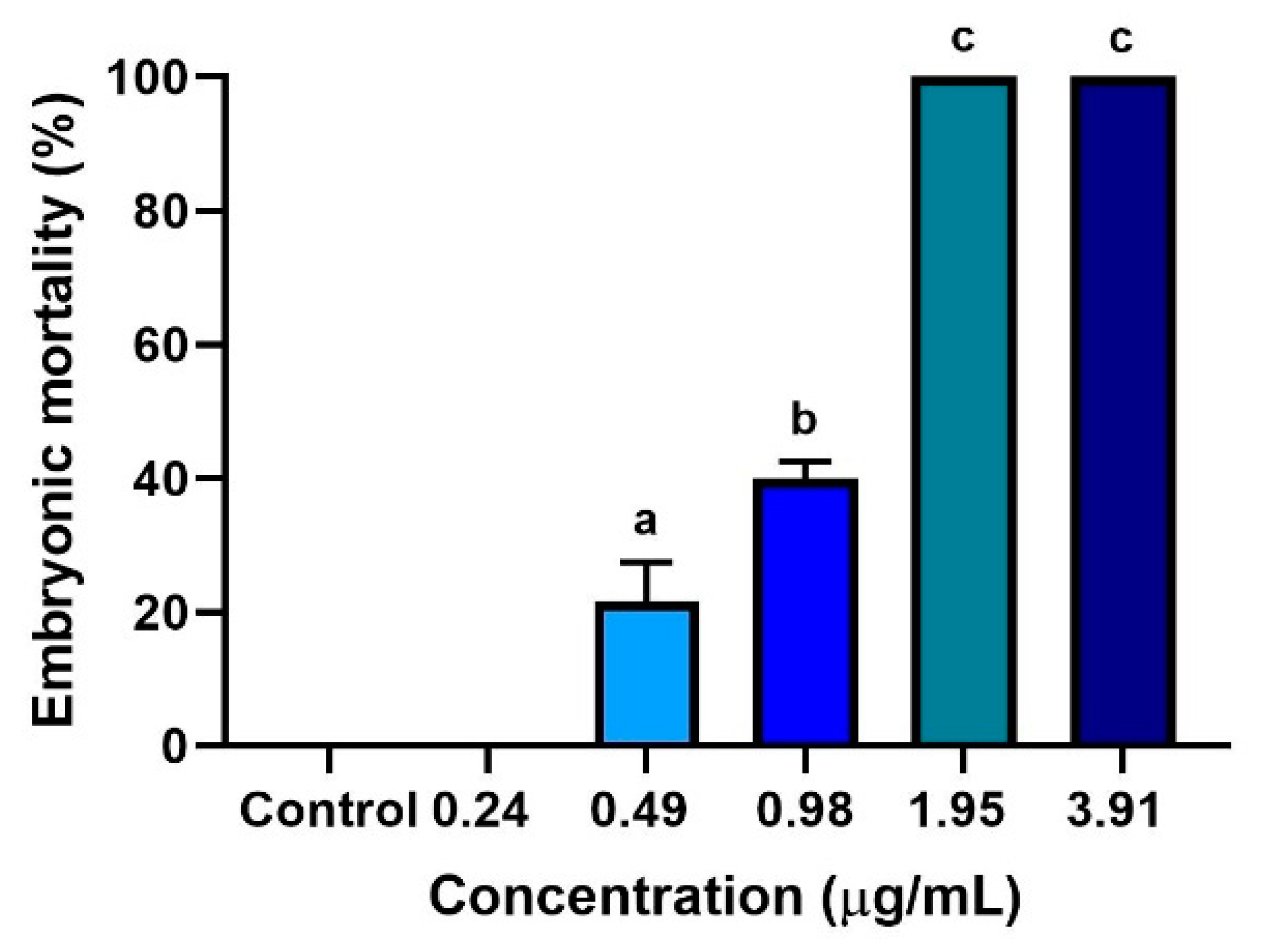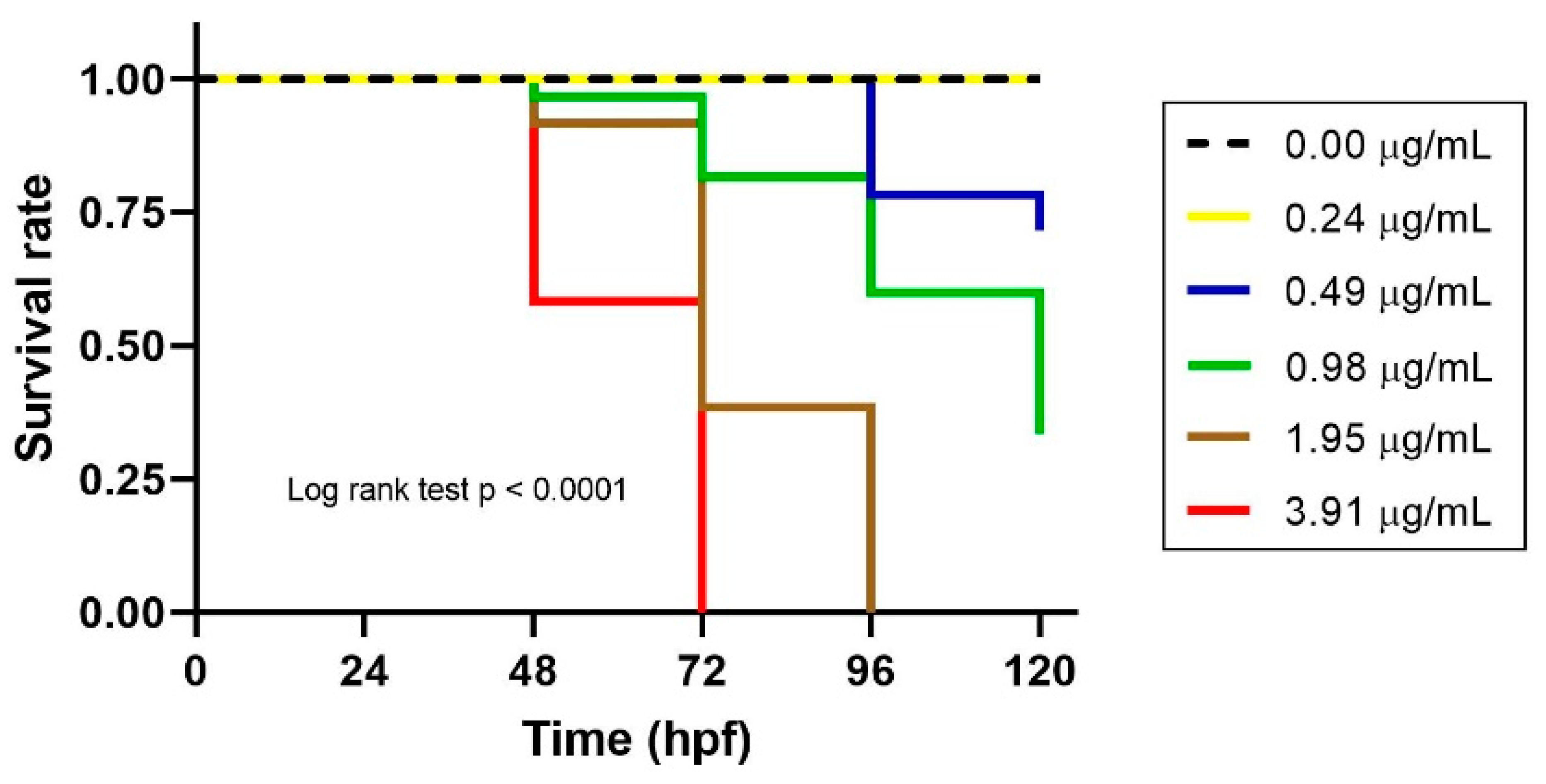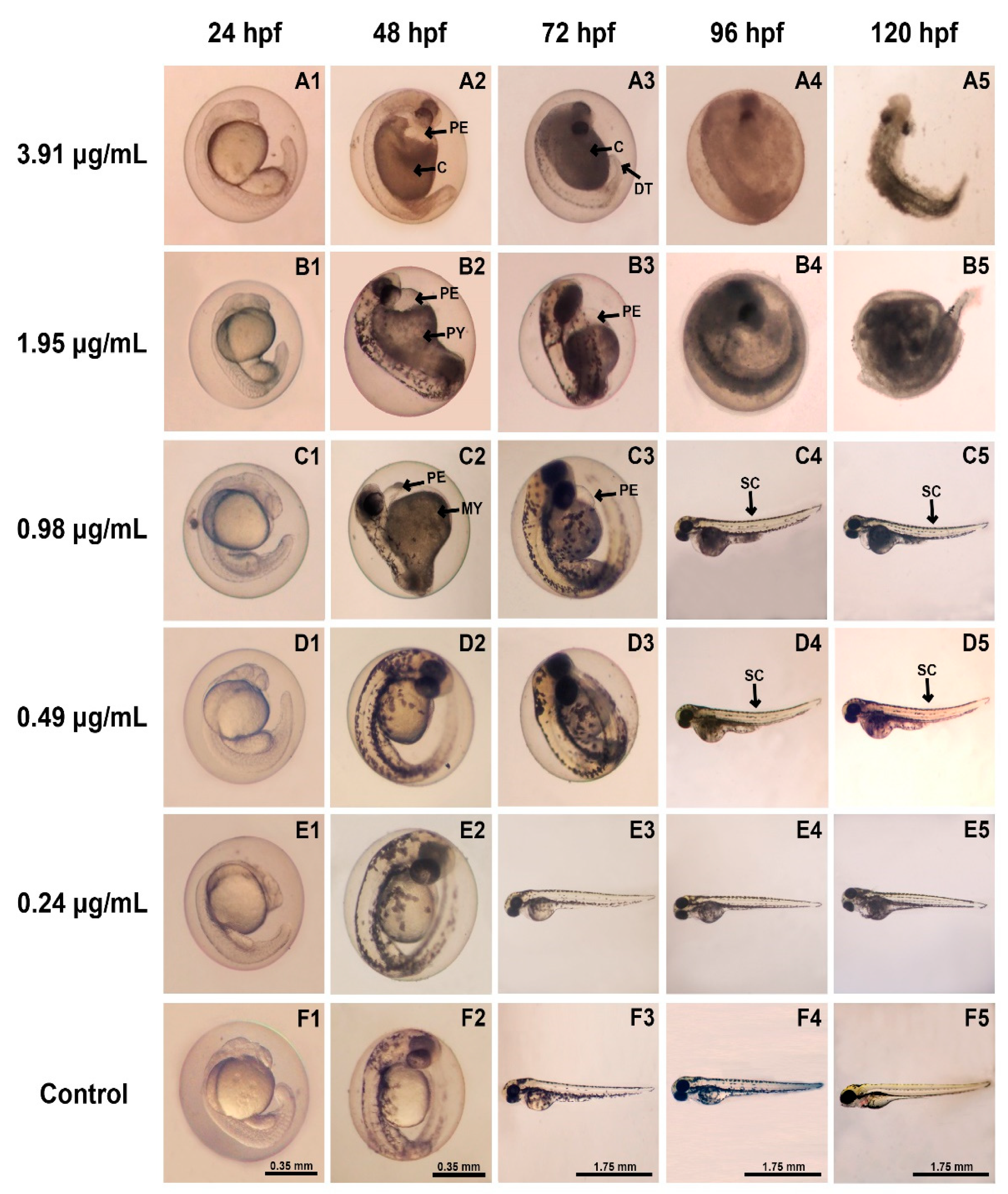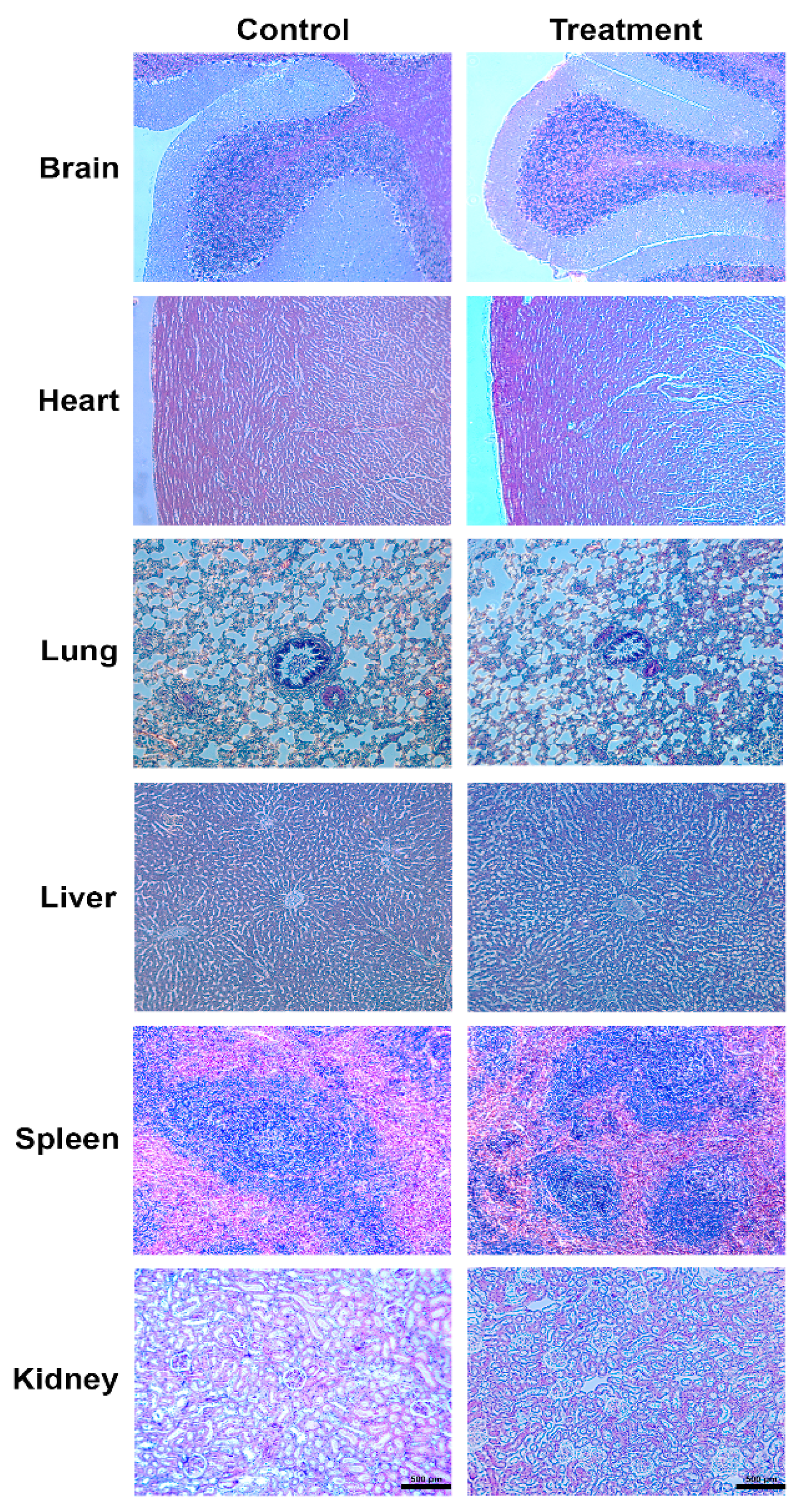Phytochemical and Safety Evaluations of Zingiber ottensii Valeton Essential Oil in Zebrafish Embryos and Rats
Abstract
:1. Introduction
2. Materials and Methods
2.1. Plant Material
2.2. Distillation and Chemical Composition Analysis of ZO Essential Oil
2.3. Laboratory Animal Care and Maintenance
2.4. Zebrafish Breeding and Embryo Care
2.5. Zebrafish Embryonic Toxicity Test
2.5.1. Dose–Response Embryotoxicity and Median Lethal Concentration (LC50)
2.5.2. Time–Kill Analysis
2.6. Zebrafish Teratogenicity Test
2.6.1. Evaluation of Morphological Characteristics
2.6.2. Evaluation of Zebrafish Embryos Hatchability
2.6.3. Evaluation of Zebrafish Larvae Heart Rates
2.7. Acute Oral Toxicity Study in Rats
2.8. Statistical Analysis
3. Results
3.1. Chemical Compositions of the Zingiber ottensii (ZO) Valeton Essential Oil
3.2. Dose–Response Embryotoxicity in Zebrafish and LC50
3.3. Time–Kill Analysis in Zebrafish Embryos
3.4. Morphological Defects of Zebrafish Embryos
3.5. Hatchability of Zebrafish Embryos
3.6. Heart Rates of Zebrafish Embryos
3.7. Lethality and Behavioral Analysis of Rats
3.8. Body Weight, Food and Water Consumption, and Relative Organ Weight Analysis
3.9. Macroscopic and Histopathological Analysis
4. Discussion
5. Conclusions
Author Contributions
Funding
Institutional Review Board Statement
Acknowledgments
Conflicts of Interest
References
- Ruttanapattanakul, J.; Wikan, N.; Okonogi, S.; Na Takuathung, M.; Buacheen, P.; Pitchakarn, P.; Potikanond, S.; Nimlamool, W. Boesenbergia rotunda extract accelerates human keratinocyte proliferation through activating ERK1/2 and PI3K/Akt kinases. Biomed. Pharmacother. 2021, 133, 111002. [Google Scholar] [CrossRef] [PubMed]
- Kunanusorn, P.; Teekachunhatean, S.; Sangdee, C.; Panthong, A. Antinociceptive and anti-inflammatory activities of a chinese herbal recipe (DJW) in animal models. Int. J. Appl. Res. Nat. Prod. 2009, 2, 972827. [Google Scholar]
- Arpornchayanon, W.; Gomonchareonsiri, S.; Chansakaow, S.; Wongpakaran, T.; Varnado, P.; Wongpakaran, N. Acute effects of essential oil blend containing phlai oil on mood among healthy male volunteers: Randomized controlled trial. J. Complement. Integr. Med. 2019, 17, 1–7. [Google Scholar] [CrossRef] [PubMed]
- Romagosa, C.M.R.; David, E.S.; Dulay, R.M.R. Embryo-toxic and teratogenic effects of Tinospora cordifolia leaves and bark extracts in Zebrafish (Danio rerio) embryos. Asian J. Plant Sci. Res. 2016, 6, 37–41. [Google Scholar]
- Ng’uni, T.; Klaasen, J.A.; Fielding, B.C. Acute toxicity studies of the South African medicinal plant Galenia africana. Toxicol. Rep. 2018, 5, 813–818. [Google Scholar] [CrossRef]
- Lele, Z.; Krone, P.H. The zebrafish as a model system in developmental, toxicological and transgenic research. Biotechnol. Adv. 1996, 14, 57–72. [Google Scholar] [CrossRef]
- Kimmel, C.B.; Ballard, W.W.; Kimmel, S.R.; Ullmann, B.; Schilling, T.F. Stages of embryonic development of the zebrafish. Dev. Dyn. 1995, 203, 253–310. [Google Scholar] [CrossRef]
- Jayasinghe, C.D.; Jayawardena, U.A. Toxicity assessment of herbal medicine using zebrafish embryos: A systematic review. Evid. Based Complement. Alternat. Med. 2019, 2019, 7272808. [Google Scholar] [CrossRef] [Green Version]
- Lammer, E.; Carr, G.; Wendler, K.; Rawlings, J.; Belanger, S.; Braunbeck, T. Is the fish embryo toxicity test (FET) with the zebrafish (Danio rerio) a potential alternative for the fish acute toxicity test? Comp. Biochem. Physiol. C Toxicol. Pharmacol. 2009, 149, 169–209. [Google Scholar] [CrossRef]
- Mendis, J.C.; Tennakoon, T.K.; Jayasinghe, C.D. Zebrafish embryo toxicity of a binary mixture of pyrethroid insecticides: D-tetramethrin and cyphenothrin. J. Toxicol. 2018, 2018, 4182694. [Google Scholar] [CrossRef]
- Halili, J.F.; Quilang, J. The zebrafish embryo toxicity and teratogenicity assay. Philipp. Biota. 2011, XLIV, 63–71. [Google Scholar]
- Quattrocchi, U. Zingiber ottensii Valeton. In CRC World Dictionary of Medicinal and Poisonous Plants: Common Names, Scientific Names, Eponyms, Synonyms, and Etymology; CRC Press: Boca Raton, FL, USA, 2012; pp. 838–839. [Google Scholar]
- Jansen, P.C.M. Zingiber ottensii Valeton. In Plant Resources of South-East Asia No. 13: Spices; de Guzman, C.C.S.J., Ed.; Backhuys Publisher: Leiden, The Netherlands, 1999; pp. 267–268. [Google Scholar]
- Burkill, I.H.; Birtwistle, W.; Foxworthy, F.W.; Scrivenor, J.B.; Watson, J.G. A Dictionary of the Economic Products of the Malay Peninsula; on Behalf of the Governments of the Straits Settlements and Federated Malay States by the Crown Agents for the Colonies: London, UK, 1935; Volume 2, p. 2302. [Google Scholar]
- Tiengburanatam, N.; Boonmee, A.; Sangvanich, P.; Karnchanatat, A. A novel α-glucosidase inhibitor protein from the rhizomes of Zingiber ottensii Valeton. Appl. Biochem. Biotechnol. 2010, 162, 1938–1951. [Google Scholar] [CrossRef]
- Karnchanatat, A.; Tiengburanatam, N.; Boonmee, A.; Puthong, S.; Sangvanich, P. Zingipain, a cysteine protease from Zingiber ottensii Valeton rhizomes with antiproliferative activities against fungi and human malignant cell lines. Prep. Biochem. Biotechnol. 2011, 41, 138–153. [Google Scholar] [CrossRef]
- Sirat, H.M.; Nordin, A.B. Essential Oil of Zingiber ottensii Valeton. J. Essent. Oil Res. 1994, 6, 635–636. [Google Scholar] [CrossRef]
- OECD. Guidelines for the Testing of Chemicals. Section 2-Effects on Biotic System Test (No 236 Fish Embryo Acute Toxicity (FET) Test); Organization for Economic Cooperation and Development: Paris, France, 2013. [Google Scholar]
- Zebrafish Embryo Medium. Available online: http://cshprotocols.cshlp.org/content/2011/8/pdb.rec12478.full (accessed on 24 February 2021).
- Mektrirat, R.; Yano, T.; Okonogi, S.; Katip, W.; Pikulkaew, S. Phytochemical and safety evaluations of volatile terpenoids from Zingiber cassumunar Roxb. on mature carp peripheral blood mononuclear cells and embryonic zebrafish. Molecules 2020, 25, 613. [Google Scholar] [CrossRef] [PubMed] [Green Version]
- Pamanji, R.; Yashwanth, B.; Bethu, M.S.; Leelavathi, S.; Ravinder, K.; Rao, J.V. Toxicity effects of profenofos on embryonic and larval development of Zebrafish (Danio rerio). Environ. Toxicol. Pharmacol. 2015, 39, 887–897. [Google Scholar] [CrossRef]
- Gao, X.-P.; Feng, F.; Zhang, X.-Q.; Liu, X.-X.; Wang, Y.-B.; She, J.-X.; He, Z.-H.; He, M.-F. Toxicity assessment of 7 anticancer compounds in zebrafish. Int. J. Toxicol. 2014, 33, 98–105. [Google Scholar] [CrossRef]
- Alafiatayo, A.; Lai, K.-S.; Syahida, A.; Mahmood, M.; Shaharuddin, N. Phytochemical evaluation, embryotoxicity, and teratogenic effects of Curcuma longa extract on zebrafish (Danio rerio). Evid. Based Complement. Alternat. Med. 2019, 2019, 1–10. [Google Scholar] [CrossRef] [PubMed] [Green Version]
- Lu, S.; Hu, M.; Wang, Z.; Liu, H.; Kou, Y.; Lyu, Z.; Tian, J. Generation and application of the zebrafish heg1 mutant as a cardiovascular disease model. Biomolecules 2020, 10, 1542. [Google Scholar] [CrossRef] [PubMed]
- OECD. Guidelines for the Testing of Chemicals. Section 4-Health Effects (No 420 Acute Oral Toxicity—Fixed Dose Procedure); Organization for Economic Cooperation and Development: Paris, France, 2002. [Google Scholar]
- Balin, P.; Zanatta, F.; Jorge, B.; Leitão, M.; Kassuya, R.; Cardoso, C.; Kassuya, C.; Arena, A. Toxicological evaluation and anti-inflammatory potential of an ethanolic extract from Bromelia balansae (Bromeliaceae) fruit. J. Ethnopharmacol. 2018, 222, 79–86. [Google Scholar] [CrossRef] [PubMed] [Green Version]
- Syahmi, A.R.M.; Vijayarathna, S.; Sasidharan, S.; Latha, L.Y.; Kwan, Y.P.; Lau, Y.L.; Shin, L.N.; Chen, Y. Acute oral toxicity and brine shrimp lethality of Elaeis guineensis Jacq., (oil palm leaf) methanol extract. Molecules 2010, 15, 8111–8121. [Google Scholar] [CrossRef] [Green Version]
- Lieschke, G.J.; Currie, P.D. Animal models of human disease: Zebrafish swim into view. Nat. Rev. Genet. 2007, 8, 353–367. [Google Scholar] [CrossRef]
- De Luca, E.; Zaccaria, G.M.; Hadhoud, M.; Rizzo, G.; Ponzini, R.; Morbiducci, U.; Santoro, M.M. ZebraBeat: A flexible platform for the analysis of the cardiac rate in zebrafish embryos. Sci. Rep. 2014, 4, 4898. [Google Scholar] [CrossRef] [Green Version]
- Kumar, R.B.S.; Kar, B.; Dolai, N.; Haldar, P. Study on developmental toxicity and behavioral safety of Streblus asper Lour. bark on zebrafish embryos. Indian J. Nat. Prod. Resour. 2013, 4, 255–259. [Google Scholar]
- Thubthimthed, S.; Limsiriwong, P.; Rerk-am, U.; Suntorntanasat, T. Chemical composition and cytotoxic activity of the essential oil of Zingiber ottensii. Acta Horti. 2005, 675, 107–109. [Google Scholar] [CrossRef]
- Marliani, L.S.A.; Moelyono, M.W.; Halimah, E.; Pratiwi, F.W.; Suhardiman, A. Essential oil components of leaves and rhizome of Zingiber ottensii Val. from Bandung, Indonesia. Res. J. Chem. Environ. 2018, 22, 54–57. [Google Scholar]
- Manochai, B.; Paisooksantivatana, Y.; Choi, H.; Hong, J.H. Variation in DPPH scavenging activity and major volatile oil components of cassumunar ginger, Zingiber montanum (Koenig), in response to water deficit and light intensity. Sci. Horti. 2010, 126, 462–466. [Google Scholar] [CrossRef]
- Kalantari, K.; Moniri, M.; Boroumand Moghaddam, A.; Abdul Rahim, R.; Bin Ariff, A.; Izadiyan, Z.; Mohamad, R. A review of the biomedical applications of zerumbone and the techniques for its extraction from ginger rhizomes. Molecules 2017, 22, 1645. [Google Scholar] [CrossRef] [Green Version]
- de Freitas Souza, C.; Baldissera, M.; Silva, L.; Geihs, M.; Baldisserotto, B. Is monoterpene terpinen-4-ol the compound responsible for the anesthetic and antioxidant activity of Melaleuca alternifolia essential oil (tea tree oil) in silver catfish? Aquaculture 2018, 486, 217–223. [Google Scholar] [CrossRef]
- Ali, M.; Saba, S.; Taite, D.; Emadi, S.; Irving, R. The protective layer of zebrafish embryo changes continuously with advancing ages of embryo development(AGED). J. Toxicol. Pharmacolo. 2017, 1, 9. [Google Scholar]
- Cook, L.W.; Paradise, C.J.; Lom, B. The pesticide malathion reduces survival and growth in developing zebrafish. Environ. Toxicol. Chem. 2005, 24, 1745–1750. [Google Scholar] [CrossRef]
- Willaert, A.; Khatri, S.; Callewaert, B.; Coucke, P.; Crosby, S.; Lee, J.; Davis, E.; Shiva, S.; Tsang, M.; De Paepe, A.; et al. GLUT10 is required for the development of the cardiovascular system and the notochord and connects mitochondrial function to TGF signaling. Hum. Mol. Genet. 2011, 21, 1248–1259. [Google Scholar] [CrossRef] [Green Version]
- Murugesu, S.; Khatib, A.; Ahmed, Q.U.; Ibrahim, Z.; Uzir, B.F.; Benchoula, K.; Yusoff, N.I.N.; Perumal, V.; Alajmi, M.F.; Salamah, S.; et al. Toxicity study on Clinacanthus nutans leaf hexane fraction using Danio rerio embryos. Toxicol. Rep. 2019, 6, 1148–1154. [Google Scholar] [CrossRef]
- Trikić, M.Z.; Monk, P.; Roehl, H.; Partridge, L.J. Regulation of zebrafish hatching by tetraspanin cd63. PLoS ONE 2011, 6, e19683. [Google Scholar] [CrossRef] [Green Version]
- Braunbeck, T.; Böttcher, M.; Hollert, H.; Kosmehl, T.; Lammer, E.; Leist, E.; Rudolf, M.; Seitz, N. Towards an alternative for the acute fish LC50 test in chemical assessment: The fish embryo toxicity test goes multi-species—An update. Altex 2005, 22, 87–102. [Google Scholar]
- Dougnon, G.; Ito, M. Sedative effects of the essential oil from the leaves of Lantana camara occurring in the Republic of Benin via inhalation in mice. J. Nat. Med. 2019, 74, 159–169. [Google Scholar] [CrossRef]
- Felipe, C.; Albuquerque, A.; Pontes, J.; Melo, J.; Rodrigues, T.; Sousa, A.; Monteiro, Á.; Ribeiro, A.; Lopes, J.; Almeida, R. Comparative study of alpha- and beta-pinene effect on PTZ-induced convulsions in mice. Fundam. Clin. Pharmacol. 2018, 33, 181–190. [Google Scholar] [CrossRef]
- Cassar, S.; Beekhuijzen, M.; Beyer, B.; Chapin, R.; Dorau, M.; Hoberman, A.; Krupp, E.; Leconte, I.; Stedman, D.; Stethem, C.; et al. A multi-institutional study benchmarking the zebrafish developmental assay for prediction of embryotoxic plasma concentrations from rat embryo–fetal development studies. Reprod. Toxicol. 2019, 86, 33–44. [Google Scholar] [CrossRef]






| Peaks | RT (Min) | Component | Formula | MW (g/moL) | Amount (%) |
|---|---|---|---|---|---|
| 1 | 6.39 | α-pinene | C10H16 | 136.23 | 2.94 |
| 2 | 7.55 | sabinene | C10H16 | 136.23 | 15.19 |
| 3 | 7.69 | β-pinene | C10H16 | 136.23 | 7.95 |
| 4 | 9.34 | 1,8-cineole | C10H18O | 154.25 | 3.16 |
| 5 | 10.18 | γ-terpinene | C10H16 | 136.23 | 3.73 |
| 6 | 14.49 | terpinen-4-ol | C10H18O | 154.25 | 18.75 |
| 7 | 14.87 | α-terpineol | C10H18O | 154.25 | 1.67 |
| 8 | 23.37 | β-selinene | C15H24 | 204.35 | 4.48 |
| 9 | 29.24 | α-eudesmol | C15H22O | 222.37 | 0.95 |
| 10 | 31.50 | zerumbone | C15H22O | 218.33 | 24.73 |
| Concentrations (µg/mL) | Hours Post Fertilization (hpf) | ||||
|---|---|---|---|---|---|
| 24 | 48 | 72 | 96 | 120 | |
| 0 | 0 | 0 | 0 | 0 | 0 |
| 0.24 | 0 | 0 | 0 | 0 | 0 |
| 0.49 | 0 | 0 | 40.17 ± 2.25 | 75.36 ± 4.84 | 79.28 ± 8.24 |
| 0.98 | 0 | 18.99 ± 4.15 | 91.50 ± 8.10 | 100 | 100 |
| 1.95 | 0 | 47.30 ± 21.75 | 100 | ED | ED |
| 3.91 | 0 | 100 | ED | ED | ED |
| Observation | Control Group (0.9% Saline) | Treatment Group (2000 mg/kg of ZO Essential Oil) | ||||||||
|---|---|---|---|---|---|---|---|---|---|---|
| 6 h | 12 h | 24 h | 7 d | 14 d | 6 h | 12 h | 24 h | 7 d | 14 d | |
| Behavioral patterns | N | N | N | N | N | N | N | N | N | N |
| Skin and Fur | N | N | N | N | N | N | N | N | N | N |
| Eye and Ears | N | N | N | N | N | N | N | N | N | N |
| Mucous membrane | N | N | N | N | N | N | N | N | N | N |
| Heartbeat | N | N | N | N | N | N | N | N | N | N |
| Breathing | N | N | N | N | N | N | N | N | N | N |
| Sedation | - | - | - | - | - | +/- | +/- | - | - | - |
| Lethargy | - | - | - | - | - | +/- | +/- | - | - | - |
| Ataxia | - | - | - | - | - | +/- | +/- | - | - | - |
| Salivation | - | - | - | - | - | - | - | - | - | - |
| Diarrhea | - | - | - | - | - | - | - | - | - | - |
| Convulsion | - | - | - | - | - | - | - | - | - | - |
| Parameters | Control Group (0.9% Saline) | Treatment Group (2000 mg/kg of ZO Essential Oil) |
|---|---|---|
| Initial weight (g) | 185.00 ± 5.00 | 183.00 ± 4.47 |
| Final weight (g) | 213.60 ± 7.40 | 214.40 ± 3.43 |
| Body weight gain (%) | 12.62 ± 3.51 | 12.14 ± 1.67 |
| Food intake (g/day) | 13.89 ± 0.04 | 13.57 ± 0.73 |
| Water intake (mL/day) | 29.68 ± 2.27 | 31.85 ± 2.66 |
| Organ (g/100 g Body Weight) | Control Group (0.9% Saline) | Treatment Group (2000 mg/kg of ZO Essential Oil) |
|---|---|---|
| Brain | 0.93 ± 0.09 | 0.89 ± 0.02 |
| Heart | 0.32 ± 0.01 | 0.30 ± 0.02 |
| Liver | 4.63 ± 0.22 | 4.51 ± 0.10 |
| Kidney | 0.50 ± 0.02 | 0.49 ± 0.01 |
| Spleen | 0.25 ± 0.02 | 0.25 ± 0.03 |
| Thymus gland | 0.21 ± 0.03 | 0.20 ± 0.04 |
| Ovary | 0.03 ± 0.01 | 0.03 ± 0.01 |
| Uterus | 0.25 ± 0.02 | 0.28 ± 0.06 |
| Adrenal gland | 0.02 ± 0.00 | 0.02 ± 0.00 |
| Lung | 0.52 ± 0.04 | 0.75 ± 0.23 |
Publisher’s Note: MDPI stays neutral with regard to jurisdictional claims in published maps and institutional affiliations. |
© 2021 by the authors. Licensee MDPI, Basel, Switzerland. This article is an open access article distributed under the terms and conditions of the Creative Commons Attribution (CC BY) license (https://creativecommons.org/licenses/by/4.0/).
Share and Cite
Thitinarongwate, W.; Mektrirat, R.; Nimlamool, W.; Khonsung, P.; Pikulkaew, S.; Okonogi, S.; Kunanusorn, P. Phytochemical and Safety Evaluations of Zingiber ottensii Valeton Essential Oil in Zebrafish Embryos and Rats. Toxics 2021, 9, 102. https://0-doi-org.brum.beds.ac.uk/10.3390/toxics9050102
Thitinarongwate W, Mektrirat R, Nimlamool W, Khonsung P, Pikulkaew S, Okonogi S, Kunanusorn P. Phytochemical and Safety Evaluations of Zingiber ottensii Valeton Essential Oil in Zebrafish Embryos and Rats. Toxics. 2021; 9(5):102. https://0-doi-org.brum.beds.ac.uk/10.3390/toxics9050102
Chicago/Turabian StyleThitinarongwate, Wisit, Raktham Mektrirat, Wutigri Nimlamool, Parirat Khonsung, Surachai Pikulkaew, Siriporn Okonogi, and Puongtip Kunanusorn. 2021. "Phytochemical and Safety Evaluations of Zingiber ottensii Valeton Essential Oil in Zebrafish Embryos and Rats" Toxics 9, no. 5: 102. https://0-doi-org.brum.beds.ac.uk/10.3390/toxics9050102







